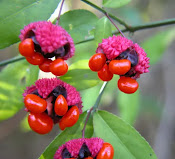Bleeding Heart (Lamprocapnos spectabilis)
In early spring and summer, the delicate arching branches of this elegant perennial fill with puffy heart-shaped petals that have protruding white inner petals. Most commonly the outer petals are pink, but there are some all-white versions. The Bleeding Heart is native to countries in Northern Asia (Siberia, Korea, Northern China and Japan) and North America. Here is a video with more information on this garden favorite.
Fun Fact: In Japan there is a legend about a man who falls deeply in love with a beautiful woman and spends everything he has on gifts trying to win her. The hard-hearted woman takes the gifts but rejects him. Penniless and heartbroken, he stabs himself in the heart. The cool thing about this story is that it can be told by using the various parts of the flower – see that here.
Forget-Me-Not (Myosotis sylvatica)
These popular plants have grey-green, hairy stems and an abundance of little flowers that can bloom throughout the growing season. To me, these flowers look like the typical flower that children draw; but their name comes from two Greek words: “mus” for “mouse and “otis” for “ears”, so others must think they look like mouse ears. These flowers are generally blue with yellow centers, but with 50 species in the family you’ll find pink and white variations as well. Forget-Me-Not flowers are relatively scent-free during the day, but at night they become very fragrant. This plant carries much symbolism, read more about it here.Love Lies Bleeding (Amaranthus Caudatus)


Hearts-A-Bursting (Euonymus americanus)
 This deciduous shrub is native to the east coast of the US, from Florida all the way to Canada. The flowers of this plant are fairly non-descript; it’s the showy fruit that gives it is name. When the fruit appears it’s glossy red, with a warty strawberry-like texture. As it becomes mature, the fruit opens to expose a glossy, almost neon-orange berry. All parts of this plant are poisonous and should not be ingested by humans. It is a favorite of wildlife, however, and they can eat it with impunity.
This deciduous shrub is native to the east coast of the US, from Florida all the way to Canada. The flowers of this plant are fairly non-descript; it’s the showy fruit that gives it is name. When the fruit appears it’s glossy red, with a warty strawberry-like texture. As it becomes mature, the fruit opens to expose a glossy, almost neon-orange berry. All parts of this plant are poisonous and should not be ingested by humans. It is a favorite of wildlife, however, and they can eat it with impunity.
Fun Fact: The European version of this plant, Euonymus europaeus, is known as the Spindletree because its spines were used to make the sharp spindles on spinning wheels. In the tale of Sleeping Beauty, she pricks her finger on her spinning wheel and falls asleep - or into a coma. This came from the once-popular belief that the wood was so poisonous that even the smallest cut could cause comas and death.
Lad’s Love (Artemisia Abrotanum)

 This herbaceous shrub grows to be about 3’ x 3’ and has aromatic and bushy fern-like leaves. Lad’s Love is originally from southern Europe, but it was first introduced to our continent way back in the 1600s. This plant has a ridiculous number of common names, but Southernwood is one of the most widely used. People enjoy this plant just for its lemony, camphor-like scent and lovely foliage, but over the years it has been used for everything from pest control to medicine. One if it’s common names is “Maiden’s Ruin’, which reflects one of its rumored qualities – it’s supposed to be an aphrodisiac. Check out this video for one man’s adults-only take on the smell.
This herbaceous shrub grows to be about 3’ x 3’ and has aromatic and bushy fern-like leaves. Lad’s Love is originally from southern Europe, but it was first introduced to our continent way back in the 1600s. This plant has a ridiculous number of common names, but Southernwood is one of the most widely used. People enjoy this plant just for its lemony, camphor-like scent and lovely foliage, but over the years it has been used for everything from pest control to medicine. One if it’s common names is “Maiden’s Ruin’, which reflects one of its rumored qualities – it’s supposed to be an aphrodisiac. Check out this video for one man’s adults-only take on the smell.
Submitted by Pam












No comments:
Post a Comment